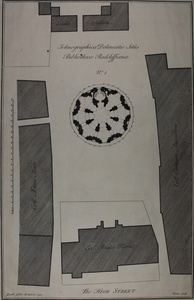| Method | Copper engraving |
| Artist | George Vertue after James Gibbs |
| Published | c 1740 |
| Dimensions | Image 490 x 305 mm |
| Notes |
A plan of the Radcliffe Camera from Bibliotheca Radcliviana: or, a Short Description of the Radcliffe Library, at Oxford, Containing Is Several Plans, Uprights, Sections, and Ornaments, On Twenty three copper Plates, neatly engraved, With the Explanation of each Plate. George Vertue (1684-1756) was an antiquary and engraver. Vertue had a deep interest in antiquarian research, and much of his work was devoted to this subject. From 1713 onwards, Vertue dedicated his research to details of the history of British art, resulting in extensive notebooks now in the Britsh Library. The contents of these was the basis of Horace Walpole's 1762 Anecdotes of Painting. There are approximately five hundred portraits attributed to Vertue, an equivalent number of published plates were devoted to antiquarian subjects. James Gibbs (1682-1754) was a British architect. Born in Aberdeen, Gibbs travelled extensively as a young man. In Italy he trained as an architect under Carlo Fontana. In London, he was responsible for the church of St. Mary-le-Strand, and the rebuilding of St. Martin-in-the-Fields. In Oxford, he was responsible for the Radcliffe Camera; the completion of the interior of Codrington Library, All Souls; and a new screen in the Hall of St John's. He was elected a member of the Society of Antiquaries in London in 1726 and fellow of the Royal Society in 1729. He published A Book of Architecture (1728); Rules for Drawings the Several Parts of Architecture (1732); and Biblioteca Radcliviana (1747). |
| Framing | unmounted |
| Price | £100.00 |
| Stock ID | 11083 |

